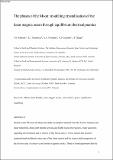Files in this item
The phases of the Moon : modelling crystallisation of the lunar magma ocean through equilibrium thermodynamics
Item metadata
| dc.contributor.author | Johnson, T. E. | |
| dc.contributor.author | Morrissey, L. J. | |
| dc.contributor.author | Nemchin, A. A. | |
| dc.contributor.author | Gardiner, N. J. | |
| dc.contributor.author | Snape, J. F. | |
| dc.date.accessioned | 2022-02-15T00:38:41Z | |
| dc.date.available | 2022-02-15T00:38:41Z | |
| dc.date.issued | 2021-02-15 | |
| dc.identifier | 272310923 | |
| dc.identifier | 0ab68a7b-9a28-4fdd-b22e-c49286e79aed | |
| dc.identifier | 85098540306 | |
| dc.identifier | 000605759500005 | |
| dc.identifier.citation | Johnson , T E , Morrissey , L J , Nemchin , A A , Gardiner , N J & Snape , J F 2021 , ' The phases of the Moon : modelling crystallisation of the lunar magma ocean through equilibrium thermodynamics ' , Earth and Planetary Science Letters , vol. 556 , 116721 . https://doi.org/10.1016/j.epsl.2020.116721 | en |
| dc.identifier.issn | 0012-821X | |
| dc.identifier.other | ORCID: /0000-0003-3465-9295/work/86987310 | |
| dc.identifier.uri | https://hdl.handle.net/10023/24873 | |
| dc.description | Funding: TEJ acknowledges support from the State Key Laboratory for Geological Processes and Mineral Resources, China University of Geosciences, Wuhan (Open Fund GPMR201903 ). We thank J. B. Balta and T. Prissel for their challenging reviews that led to significant improvements in the final version. | en |
| dc.description.abstract | Despite some 50 years of intense research on samples returned from the Apollo missions and lunar meteorites, along with remote-sensing and Earth-based observations, many questions regarding the formation and evolution of the Moon persist. These include the detailed compositional and density structure of the lunar mantle and the source and petrogenesis of the diverse suite of extrusive and intrusive igneous rocks. There is broad agreement that the primary internal structure of the Moon reflects crystallisation of a lunar magma ocean (LMO), and that an inverted density gradient within the mantle cumulates led to some reorganisation of layers by partial convective overturn. Experimental studies have provided invaluable constraints on crystallisation of the LMO, but are limited by the relatively small number of experiments that can practically be undertaken. Here we use recently-developed thermodynamic models for minerals and melt in the K2O–Na2O–CaO–FeO–MgO–Al2O3–SiO2–TiO2–Cr2O3 system to model crystallisation of a full-moon LMO based on two existing end-member bulk compositions—Taylor Whole-Moon (TWM), and Lunar Primitive Upper Mantle, LPUM—on which many experimental studies have been based. We follow several recent studies in considering equilibrium crystallisation of the first 50 vol.% and fractional crystallisation thereafter. Our results match well with experimental studies, and provide detailed constraints on the major oxide composition, mineralogy and density structure based on the two starting compositions that, while exhibiting some similarities, show important differences. The more fertile TWM composition contains significant quantities of garnet in the deep mantle, whereas the LPUM composition has none. By contrast, prior to any gravitational overturn, the uppermost mantle cumulates for TWM are strongly silica-undersaturated and contain abundant aluminous spinel, whereas those for LPUM are silica-saturated. For both starting compositions, with the exception of TiO2 and Na2O, our modelled compositions of the final dregs of fractionated melt show a reasonable match with existing estimates on the composition of urKREEP. Modelled partial melts of the upper-mantle cumulates at low to moderate melt fractions have major oxide compositions that match well with low- and intermediate-Ti lunar basalts. The correspondence is particularly good for picritic (green) glasses that likely represent melts derived from deeper levels within the upper mantle. The wide spread in TiO2 concentrations in lunar basalts and basaltic glasses is consistent with density-driven reorganisation involving ilmenite. Our simulations provide thermodynamically-robust estimates of the compositional, mineralogical and density structure of the lunar interior that are unprecedented in their detail, and which provide the foundation for several lines of future research addressing the origin and secular evolution of the Moon. | |
| dc.format.extent | 13 | |
| dc.format.extent | 6961696 | |
| dc.language.iso | eng | |
| dc.relation.ispartof | Earth and Planetary Science Letters | en |
| dc.subject | Lunar basalts | en |
| dc.subject | Lunar magma ocean | en |
| dc.subject | Lunar mantle | en |
| dc.subject | Moon | en |
| dc.subject | Phase equilibrium modelling | en |
| dc.subject | QB Astronomy | en |
| dc.subject | QC Physics | en |
| dc.subject | QE Geology | en |
| dc.subject | Earth and Planetary Sciences (miscellaneous) | en |
| dc.subject | Geochemistry and Petrology | en |
| dc.subject | Geophysics | en |
| dc.subject | Space and Planetary Science | en |
| dc.subject | DAS | en |
| dc.subject.lcc | QB | en |
| dc.subject.lcc | QC | en |
| dc.subject.lcc | QE | en |
| dc.title | The phases of the Moon : modelling crystallisation of the lunar magma ocean through equilibrium thermodynamics | en |
| dc.type | Journal article | en |
| dc.contributor.institution | University of St Andrews. School of Earth & Environmental Sciences | en |
| dc.identifier.doi | https://doi.org/10.1016/j.epsl.2020.116721 | |
| dc.description.status | Peer reviewed | en |
| dc.date.embargoedUntil | 2022-02-15 |
This item appears in the following Collection(s)
Items in the St Andrews Research Repository are protected by copyright, with all rights reserved, unless otherwise indicated.

